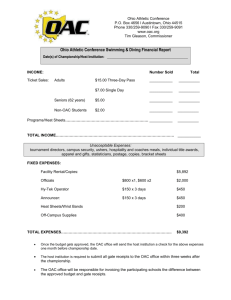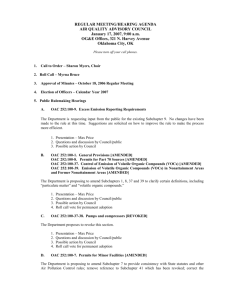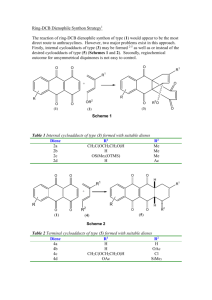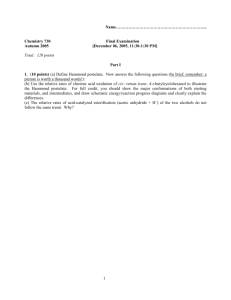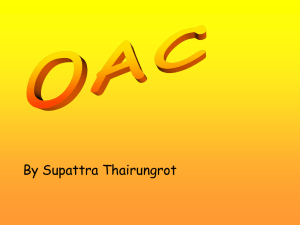Microsoft Word
advertisement
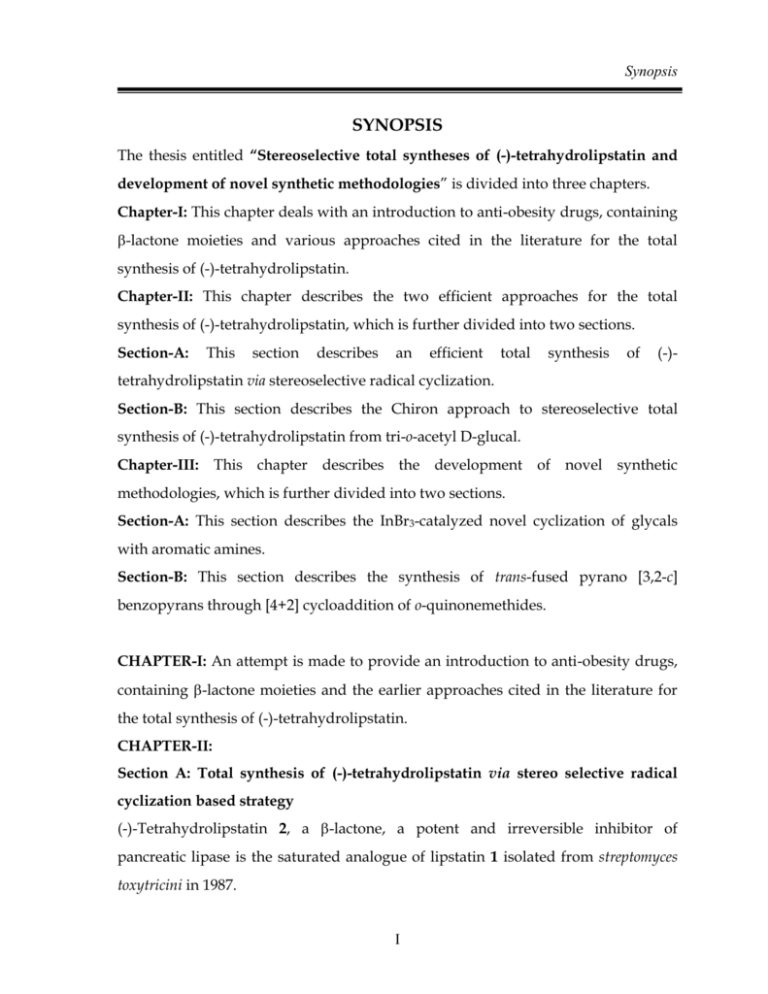
Synopsis SYNOPSIS The thesis entitled “Stereoselective total syntheses of (-)-tetrahydrolipstatin and development of novel synthetic methodologies” is divided into three chapters. Chapter-I: This chapter deals with an introduction to anti-obesity drugs, containing -lactone moieties and various approaches cited in the literature for the total synthesis of (-)-tetrahydrolipstatin. Chapter-II: This chapter describes the two efficient approaches for the total synthesis of (-)-tetrahydrolipstatin, which is further divided into two sections. Section-A: This section describes an efficient total synthesis of (-)- tetrahydrolipstatin via stereoselective radical cyclization. Section-B: This section describes the Chiron approach to stereoselective total synthesis of (-)-tetrahydrolipstatin from tri-o-acetyl D-glucal. Chapter-III: This chapter describes the development of novel synthetic methodologies, which is further divided into two sections. Section-A: This section describes the InBr3-catalyzed novel cyclization of glycals with aromatic amines. Section-B: This section describes the synthesis of trans-fused pyrano [3,2-c] benzopyrans through [4+2] cycloaddition of o-quinonemethides. CHAPTER-I: An attempt is made to provide an introduction to anti-obesity drugs, containing -lactone moieties and the earlier approaches cited in the literature for the total synthesis of (-)-tetrahydrolipstatin. CHAPTER-II: Section A: Total synthesis of (-)-tetrahydrolipstatin via stereo selective radical cyclization based strategy (-)-Tetrahydrolipstatin 2, a -lactone, a potent and irreversible inhibitor of pancreatic lipase is the saturated analogue of lipstatin 1 isolated from streptomyces toxytricini in 1987. I Synopsis Recently, it has been marketed in several countries as anti-obesity agent under the name Xenical. The key to the biological activity of the lipstatins is the lactone moiety, featuring anti-stereochemistry about the ring. The lactone has been shown to bind irreversibly to an active site serine of pancreatic lipase. NHCHO O O NHCHO O O O n-C6H13 O O O n-C11H23 Lipstatin (1) n-C6H13 Tetrahydrolipstatin (2) Figure: 1 Due to its biological properties, (-)-tetrahydrolipstatin 2 has been the subject of profound synthetic activity since its isolation. The retrosynthetic analysis is outlined in Scheme 1. n-C10H21 O n-C6H13 O O O n-C6H13 n-C10H21 COOH OBn OH 22 NHCHO (-)-THL n-C6H13 n-C10H21 n-C10H21 n-C5H11 OBn O OBn O 19 OH 17 n-C5H11 HOOC n-C10H2 1 14b Br OEt COOH OH 3 OBn OH Scheme: 1 II Synopsis (-)-Tetrahydrolipstatin 2 could be obtained in a three-step sequence from the known β-hydroxy acid 22. It is envisioned that the degradation of compound 19 could be effected by water elimination and ozonolysis sequence. The lactol would be obtained from the propargylic alcohol 14b through bromoacetal formation and stereoselective radical cyclization, which is the key step for the success of this approach. The propargylic alcohol 14b in turn was obtained from commercially available S-Malic acid 3 by carbon extension on one end and Grignard addition on other. COOH HOOC 3 OH OH OH OH 5 MeOH, BF3.OEt2 , CO2Me MeO2 C OH 0 oC-r.t., 12 h, 85% 4 BH3.SMe2, THF, 0 oC-r.t., 2 h, 90% OH PhCH(OMe)2, p-TSA, toluene, reflux, 6 h, 80% O O Ph 6 Scheme: 2 Key starting material 1, 3-benzylidine protected triol 6 was obtained from commercially available S-malic acid 3 in three steps. Thus S-malic acid 3 was converted to its dimethyl ester derivative 4 by using methanol, borantrifluoride diethyl ether (BF3.Et2O), which on treatment with borane dimethylsulfide (BH3.DMS) and a very small quantity of sodium borohydride (NaBH4) in THF afforded 1,2,4-butane triol 5 in 90% yield (Scheme 2). 6 TsCl, TEA, CH2Cl2, 0 oC-r.t., 92% OTs O O n-C10H21MgBr, CuBr, THF, 0 oC-r.t., 76% Ph 7 O O Ph 8 Scheme: 3 III n-C10H21 Synopsis Selective protection of 2 and 4 hydroxy functions of the triol 5 with benzaldehyde dimethyl acetal, p-TSA in CH2Cl2 gave the acetal 6. The primary alcohol was transformed to tosylate 7, which on copper mediated C-C bond formation with Grignard reagent, n-decylmagnesiumbromide resulted in coupled product 8. The same was achieved by converting the alcohol 6 to corresponding triflate and copper mediated Grignard addition (Scheme 3). n-C10H21 Ph3CHCO2Et, CH2Cl2, CHO n-C10H21 CO2Et 9 r.t., 12 h, 82% DIBAL-H, CH2Cl2, -78 oC, 2 h, n-C10H21 OH n-C10H21 MS 4 Ao , TBHP, -20 oC, 83% 10 O OH D(-)-DET, Ti(iOPr)4, (i) Red-Al, THF, 0 oC-r.t., 12 h, (ii) PhCH(OMe)2, pTSA, CH2Cl2, reflux, 6 h, 79% 11 O n-C10H21 O Ph 8 Scheme: 4 Compound 8 can also be obtained in 3-step sequence from dodecanal 9 via Sharpless asymmetric epoxidation. Accordingly dodecanal on Wittig olefination with stable ylide ethoxycarbonylmethylenetriphenylphosphorane in benzene 8 DIBAL-H, CH2Cl2, (COCl)2, DMSO,TEA, CH2Cl2, -78 oC, 2 h n-C10H21 OBn OH -78 oC, 3 h, 69% 13 Then n-C7H12MgBr, 0 oC-r.t., 5 h, 82% n-C5H11 n-C5H11 n-C10H21 + n-C10H21 OBn OH 14a DEAD, TPP, p-NBA, THF, 0 oC, 88% Scheme: 5 IV OBn OH 14b Synopsis yielded - unsaturated ester 10, which on reduction with DIBAL-H in CH2Cl2 gave allyl alcohol 11. Allyl alcohol 11 on Sharpless epoxidation with D (-) DET gave epoxy alcohol 12 which on reductive and regioselective opening with Red-Al gave 1, 3-diol, followed by protection with benzaldehyde dimethyl acetal yielded 8 (Scheme 4). Reductive and regioselective opening of benzylidine acetal 8 was easily carried out using DIBAL-H to produce 13. Oxidation of 13 under Swern conditions followed by heptynyl Grignard addition resulted in cis and trans propargylic alcohols 14a and 14b in 1:1 ratio. The unrequired diastereomer 14a was converted to 14b under standard Mitsunobu conditions to obtain 14b in 72 % overall yield (Scheme 5). n-C5H11 n-C10H21 n-C5H11 n-C10H21 + OBn OH OBn OH 14b (i) LiAlH4, THF, 0 oC-r.t. 14a (i) LiAlH4, THF, 0 oC-r.t. (ii) Li-liq.NH3, -33 oC (ii) Li-liq.NH3, -33 oC (iii) 2,2-DMP, p-TSA, (iii) 2,2-DMP, p-TSA, acetone, 0 oC-r.t. acetone, 0 n-C5H11 n-C10H21 O Me 30.3 oC-r.t. 15a O Me n-C5H11 n-C10H21 19.9 98.3 25.3 O Me 15b O Me 24.8 100.1 Scheme: 6 The stereochemistry was assigned by converting both the isomers to the corresponding acetonides 15a and 15b in a three-step sequence. Reduction of propargylic to allylic system with LiAlH4 in THF and debenzylation with Li in Liq. NH3 generated 1, 3-diols which on treatment with 2, 2-DMP in acetone produced V Synopsis acetonides 15a and 15b. The 13C Analysis of these acetonides clearly revealed the stereochemistry of the diastereomers (Scheme 6). LiAlH4, THF, 14b 0 oC-r.t., 85% OBn O 17 0 oC-r.t., 90% OBn OH 16 n-C5H11 n-C10H21 NBS, EVE, CH2Cl2, n-C5H11 n-C10H21 Br n-C6H13 AIBN, n-Bu3SnH, dry toluene, n-C10H21 reflux, 2 h, 92% OEt OBn O 18 OEt Scheme: 7 Reduction of propargyl alcohol 14b with LiAlH4 in THF resulted in trans allyl alcohol 16, which on treatment with NBS and ethyl vinyl ether yielded bromoacetal 17 as an epimeric mixture at newly created acetal centre. The key step, stereo controlled radical cyclization, was easily effected by treating the bromoacetal 17 with refluxing mixture of n-Bu3SnH and catalytic AIBN in toluene to produce thermodynamically stable isomer 18 (Scheme 7). 18 80% AcOH in H2O, n-C6H13 n-C10H21 MsCl, TEA, CH2Cl2, reflux, 6 h, 78% OBn O n-C6H13 n-C10H21 OBn O 20 NaClO2-H2O, 10% NaOH, CH3CN, 0 oC-r.t., 86% -22 oC-r.t.-reflux, 92% OH 19 n-C6H13 O3, Ph3P, CH2Cl2, n-C10H21 -78 oC-r.t., 76% n-C6H13 n-C10H21 OBn OH 22 Scheme: 8 VI CO2H CHO OBn OCHO 21 Synopsis Cyclic ethyl acetal 18, when treated with 80% AcOH in H2O resulted in lactol 19. Mesylation of lactol 19 and insitu elimination was achieved by treating lactol 19 with mesyl chloride and TEA in CH2Cl2 under reflux conditions to yield cyclic vinyl ether 20. Cyclic vinyl ether 20 on ozonolytic oxidative cleavage produced aldehyde 21, which as a crude was subjected to oxidation with NaClO2 and 10 % NaOH solution to furnish β-hydroxy acid 22 (Scheme 8). 22 OBn O 0 oC-r.t., 12 h, 78% OH O 24 23 n-C6H13 n-C10H21 n-C6H13 n-C10H21 PhSO2Cl, pyridine, O O H2-Pd/C, THF, r.t., 4 h, 90% DEAD, Ph3P, (S)- N-formyl leucine, 0 oC-r.t., (-)-THL 2 2 h, 65% Scheme: 9 The β-lactone ring was formed using PhSO2Cl in pyridine, followed by debenzylation and esterification with S-N-formyl leucine under Mitsunobu conditions furnished (-)-Tetrahydrolipstatin 2 (Scheme 9). Section B: Total synthesis of (-)-tetrahydrolipstatin via Chiron approach The synthetic route depicted in Scheme 1 is based on the retrosynthetic analysis. Thus THL 2 could be obtained from a three-step sequence from the βhydroxy acid 42. VII Synopsis NH-CHO O O O n-C11H23 OH MOMO O n-C11H23 n-C11H23 n-C6H13 36 O n-C6H13 42 (-)-Tetrahydrolipstatin 2 n-C11H23 OMe O CO2H O TBSO OMe OBn O AcO AcO 33 OBn 38 O 25 OBn OAc Scheme: 10 Retrosynthetic analysis The synthetic approach begins with C-glycosidation of tri-o-acetyl D-glucal 25 by adding methanol and using CeCl3.7H2O-NaI in acetonitrile, to afford methyl acetal 26. The methyl acetal 26 was subjected to methanolysis and subsequent selective protection of 1,3-diol part to furnish 28 in 70% overall yield. O AcO AcO 25 O AcO CH3CN, Reflux, 3.5 h, 87% OAc O HO CeCl3.7H2O, NaI, MeOH, AcO OMe NaOMe, MeOH, 0 oC-r.t., 2 h, 85% 26 OAc OMe HO 27 OH Scheme: 11 The hydroxy function of compound 28 was protected as benzyl ether 29 and acetal cleavage of benzyl ether 29 was effected with p-TSA in MeOH to afford 1,3diol 30, which was selectively protected with a TBS group at the primary hydroxy group 31 and the secondary hydroxy group was protected as its xanthate ester to afford 32 in 70% yield for three steps. VIII Synopsis 27 CH2Cl2, 0 0C-r.t., 82% O O PhCH(OMe)2, p-TSA, Ph OMe NaH, BnBr, n-Bu4NI, O THF, reflux, 4 h, 78% OH 28 O O Ph OMe O OMe HO r.t., 3 h, 79% OBn O HO p-TSA, MeOH, OBn 29 30 Scheme: 12 Compound 32 was treated with n-Bu3SnH and catalytic AIBN in dry toluene under reflux conditions to afford the deoxygenated compound 33. TBSCl, imidazole, 30 TBSO O OMe HO CH2Cl2, 0 0C-r.t., 83% NaH, CS2, MeI, THF, 0 0C-r.t., 12 h, 78% OBn 31 TBSO O S H3 CS O OMe n-Bu3SnH, AIBN, PhMe, TBSO O OMe reflux, 6 h, 79% OBn OBn 32 33 Scheme: 13 The TBS group of compound 33 was removed and the resulting alcohol 34 was treated with TsCl and TEA in CH2Cl2 to afford the corresponding tosylate 35, which was treated with n-decylmagnesiumbromide and catalytic CuBr to obtain the coupled product 36. The compound 36 could also be obtained from alcohol 34 via conversion to the corresponding triflate displacement. IX and copper-mediated Grignard Synopsis TBAF, THF, 33 O HO 0 oC-r.t., 98% O TsO OMe OBn OMe TsCl, TEA, CH2Cl2, 0 oC-r.t., 92% OBn 34 n-C11H23 n-C10H21MgBr, CuBr, 0 oC-r.t., 76% O OMe OBn 36 35 Scheme: 14 The methyl acetal of 36 was converted to lactol 37 by treating with 80% aq.acetic acid, which in turn was subjected to oxidation with Dess-Martin period inane to yield lactone 38. Methanol addition to the lactone 38 was carried out in 36 80% aq.AcOH, n-C11H23 O OH reflux, 4 h, 72% Dess-Martin periodinane, CH2Cl2, 0 oC-r.t., 79% OBn 37 n-C11H23 O OBn 38 O TEA, MeOH, 0 oC-r.t., then MOMCl, DIPEA, CH2Cl2 0 oC-r.t., 71% OBn MOMO CO2Me n-C11H23 39 Scheme: 15 presence of TEA in MeOH resulted in corresponding -hydroxy ester, which without workup, on removal of MeOH under reduced pressure was protected as its MOM ether 39 in presence of DIPEA and MOMCl in CH2Cl2. Attempts made to isolate MeOH addition product, hydroxy ester, were unsuccessful as it cyclized back to lactone 38. X Synopsis 39 n-C11H23 r.t.,12 h, 94% MOMO CO2Me MOMO PhSO2Cl, py, 0 12 h, 78% CO2Me 40 n-C11H23 43 LiOH.H2O, THF, 0 oC-r.t., 88% n-C6H13 41 OH LDA, n- C6H13I, HMPA, THF, -50 oC, 75% MOMO OH n-C11H23 oC, MOMO Pd(OH)2, EtOAc, CO2H n-C11H23 42 O (i) BF3Et2O, EtSH, THF, 0 oC-r.t., 88% O OH n-C6H13 (-)-THL 2 n-C6H13 (ii) DIAD, TPP, S-N-formyl leucine, THF, 0 oC-r.t., 90% Scheme: 16 The methyl ester was hydrogenated with Pd(OH) 2 in EtOAc to afford -hydroxy ester 40. The key step, stereocontrolled alkylation, was effected by treating the -hydroxy ester 40 with LDA in THF, followed by addition of n-hexyl iodide to the dianion to give 41 as the major diastereomer in 77% yield after a flash column chromatography. The crude product of the reaction revealed ~2% of the other diastereomer. Hydroxy ester 41 was converted to -lactone 43 by hydrolysis of ester group with LiOH followed by exposure of acid 42 to PhSO2Cl in pyridine. Deprotection of MOM ether of -lactone with BF3.OEt2 and ethane dithiol in CH2Cl2 produced alcohol 24 which on esterification with (S)-N-formylleucine under Mitsunobu conditions furnished (-)-Tetrahydrolipstatin 2. CHAPTER-III: Section-A: InBr3-catalyzed cyclization of glycals with aryl amines Glycals are ambident electrophiles capable of reacting with various nucleophiles such as alcohols, silyl nucleophiles and malonates under the influence XI Synopsis of either acid catalysts or oxidants to produce 2,3-unsaturated glycosides. However, there are no precedents on the aminoglycosidation of D-glycals with aryl amines because of the intrinsic lower reactivity of amines towards glycals. In recent times, indium halides have emerged as versatile Lewis acid catalysts imparting high regio, chemo- and diastereosectivity for a variety of organic transformations. Compared to conventional Lewis acids, particularly, indium tribromide has advantages of low catalyst loading, moisture stability and catalyst recycling. C-Glycosides bearing carbon linked heterocycles have attracted great significance because of their potent antiviral and antitumour behavior. Because of the fascinating antiviral and antitumour properties of aryl glycosides, we have attempted C-glycosidation with aryl amines to synthesize aryl C-glycosides with free amino functionality for further derivatization. Interestingly, we observed for the first time an unusual formation of oxa-azatricyclotrideca-trienyl acetate derivatives in the aminoglycosidation. OAc R R1 R2 NH2 1a R1 OAc + O 2a OAc R R2 H H N H O OAc OAc 3a Scheme: 17 Initially, it is attempted to carry aminoglycosidation reaction of D-glucal with aniline using 10-mol% Indium (III) bromide as novel glycosyl activator. Interestingly, an unusal bicyclic adduct i.e. 11-methylcarbonyloxymethyl-12-oxa-8azatricyclo[7.3.1.0]trideca-2,4,6-trien-10-ylacetate was isolated in 85% yield with high stereoselectivity (Scheme 17). The product 3a thus obtained was extensively characterized by various NMR experiments like double quantum filtered correlation spectroscopy (DQFCOSY), Nuclear Over Hauser effect spectroscopy (NOESY), hetero nuclear single quantum correlation spectroscopy (HSQC) and 3JCH optimized HMBC experiments. XII Synopsis H H H 15 14 13 H 12 16 2 H H N 11 H H 3 1 O HH 4 O1 5 H O 6 9 O H H H 10 8 7 H H N H H OAc OAc O H O H H H Figure: 2 NOE's, chemical structure and energy-minimized structure of 3a These unexpected results encouraged to extend this process for various glycals and aryl amines. Interestingly, -naphthyl amine and substituted aryl amines such as electron-rich as well as electron-deficient aniline derivatives reacted efficiently with D-glucal under similar conditions to produce the corresponding cyclic adducts in fairly good yields. Similarly, L-rhamnal also underwent cyclization with aryl amine to produce 11-methyl-12-oxa-8- azatricyclo[7.3.1.0]trideca-2,4,6-trien-10-ylacetate derivative (entry 3k, Table 1). Under similar reaction conditions, D-xylal also underwent cyclization with aryl amine to afford the corresponding cyclic adduct (entry 3m, Table 1). The method is highly stereoselective to afford oxa-azatricyclodeca-trienyl acetate derivatives under mild conditions and the results are presented in Table 1. The efficacy of various Lewis acids such as InBr3, InCl3, CeCl3.7H2O, YCl3, and YbCl3 was tested for this conversion. Indium tribromide was found to be the most effective catalyst in terms of conversion and selectivity. For instance, treatment of 3,4,6-tri-O-acetyl-D-glucal with aniline in the presence of 10-mol% InBr3 and 10mol% InCl3 for 6 h afforded 85% and 72% yields respectively. However, in the absence of InBr3 or InCl3, the reaction did not proceed even after a long reaction time. The scope and generality of this process is illustrated with respect to various glycals and aryl amines. XIII Synopsis Table 1: Synthesis of oxaazatricyclotridecatrienyl derivatives from D-glucal and aryl amines (Scheme 17) Entry Aryl amine 1 Glycal 2 Producta 3 OAc H H N NH2 a OAc O H OAc Me NH2 b OAc Me H H N OAc O OAc H OAc c O F OAc F H d Cl OAc O NH2 e OAc Cl Me H Br OAc Br O H H N OAc NH2 O H H N OAc NH2 O H H N OAc O OAc Me H OAc NH2 O OAc O H H N OAc f O H O InBr3(10 mol%) Time(h) OAc Yield(%)b TMSOTf(1 eq) Time(h) Yield(%)b 6.0 85 3.5 87 5.5 82 4.0 85 7.0 78 5.0 81 6.0 84 4.5 85 8.0 75 6.0 82 9.0 80 5.0 75 OAc OAc OAc OAc OAc OAc OAc OAc OAc OAc OAc (a) Products were characterized by 1H NMR, 13C NMR, IR spectroscopy and mass spectroscopy. (b) Yield refers to pure products after chromatography. XIV Synopsis Table 1: (continued) Synthesis of oxaazatricyclotridecatrienyl derivatives from D-glucal and aryl amines Entry Aryl amine 1 Glycal Producta 2 3 OAc H H N NH2 g Br O OAc H OAc NH2 h MeO O OAc MeO O OAc H j Me OAc O OAc Me H OAc k NH2 OAc H OAc O O H H N OAc NH2 O H H N OAc O l O H H N OAc NH2 O H H N OAc NH2 i H Cl OAc Cl O H H N OAc OAc H TMSOTf(1 eq) Time(h) Yield(%)b Time(h) Yield(%)b OAc Br InBr3(10 mol%) OAc 7.5 82 4.5 84 7.0 78 4.0 78 6.0 80 5.0 83 5.5 85 4.5 89 5.0 87 5.0 85 6.0 89 3.5 82 OAc OAc OAc OAc OAc OAc OAc OAc Me OAc O (a) Products were characterized by 1H NMR, 13C NMR, IR spectroscopy and mass spectroscopy. (b) Yield refers to pure products after chromatography. XV Synopsis Section-B: Synthesis of trans-fused pyrano[3,2-c]benzopyrans through (4+2) cycloaddition of o-quinonemethides o-Quinonemethides are useful intermediates for the synthesis of many oxygenated heterocycles. Iodine has been employed as an efficient and reusable Lewis acid for the synthesis of fused tetrahydropyrano [3,2-c] benzopyrans involving intramolecular (4+2) cycloaddition of o-quinonemethides. The treatment of o-hydroxybenzaldehydes with 5-methyl-4-hexen-1-ol and trimethyl orthoformate in the presence of 5-mol% iodine in dichloromethane at ambient temperature gave exclusively trans-fused pyrano [3, 2-c] benzopyrans 2 in high yields (Scheme 18). O R H HO + H Iodine,TMOF OH CH2Cl2, r.t. O R H H O + O R H O Scheme: 18 Only a single diastereomer was obtained in each reaction, the structure of which was established by 1H, 13C NMR and mass spectroscopy. The scope and generality of this process is illustrated by reacting the substrates bearing electron donating as well as electron withdrawing groups in the aromatic ring. XVI Synopsis Table :2 Elemental iodine-catalyzed synthesis of pyrano[3,2-c]benzopyrans Entry o-Hydroxy benzaldehyde (1) Producta (2) Reaction time (h) Yield (%)b O CHO a OH 92 1.0 90 1.5 88 1.0 90 1.5 87 2.0 85 O O CHO b 1.5 OH O OMe OMe O CHO c O OH OEt OEt O d BnO CHO BnO O OH O e Me CHO Me OH f PhO CHO O O PhO OH O a All products were characterised by 1H, 13C NMR, IR and Mass spectroscopy. b Isolated and unoptimised yields. XVII Synopsis Table :2 (continued) Elemental iodine-catalyzed synthesis of pyrano[3,2-c]benzopyrans Entry o-Hydroxy benzaldehyde (1) Reaction time (h) Producta (2) Yield (%)b O CHO g OH 82 2.0 85 1.0 90 2.5 80 2.0 83 1.0 92 1.5 85 O CHO O OH h O O CHO i 1.0 OH O O CHO Br Br j OH O Br k Br Br CHO O Br OH O O l O CHO O OH O O O O m MeO CHO MeO MeO OH MeO O a All products were characterised by 1H, 13C NMR, IR and Mass spectroscopy. b Isolated and unoptimised yields. XVIII
